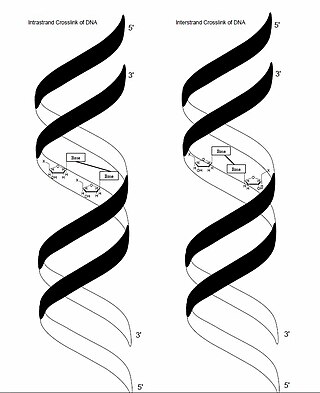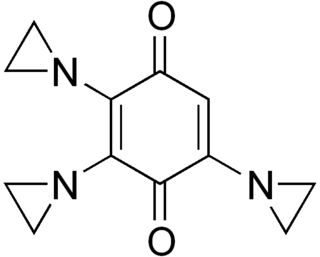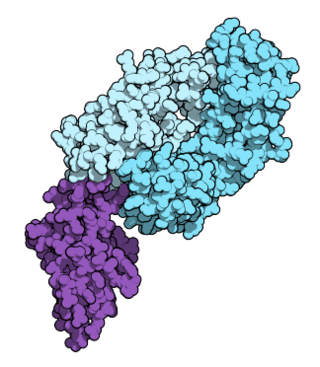
Chemotherapy is the type of cancer treatment that uses one or more anti-cancer drugs in a standard regimen. Chemotherapy may be given with a curative intent, or it may aim only to prolong life or to reduce symptoms. Chemotherapy is one of the major categories of the medical discipline specifically devoted to pharmacotherapy for cancer, which is called medical oncology.

Carboplatin, sold under the brand name Paraplatin among others, is a chemotherapy medication used to treat a number of forms of cancer. This includes ovarian cancer, lung cancer, head and neck cancer, brain cancer, and neuroblastoma. It is used by injection into a vein.

Procarbazine is a chemotherapy medication used for the treatment of Hodgkin's lymphoma and brain cancers. For Hodgkin's it is often used together with chlormethine, vincristine, and prednisone while for brain cancers such as glioblastoma multiforme it is used with lomustine and vincristine. It is typically taken by mouth.

Nitrogen mustards (NMs) are cytotoxic organic compounds with the bis(2-chloroethyl)amino ((ClC2H4)2NR) functional group. Although originally produced as chemical warfare agents, they were the first chemotherapeutic agents for treatment of cancer. Nitrogen mustards are nonspecific DNA alkylating agents.

Melphalan, sold under the brand name Alkeran among others, is a chemotherapy medication used to treat multiple myeloma; malignant lymphoma; lymphoblastic and myeloblastic leukemia; childhood neuroblastoma; ovarian cancer; mammary adenocarcinoma; and uveal melanoma. It is taken by mouth or by injection into a vein.

Fludarabine is a purine analogue and antineoplastic agent. It is generally used as its 5-O-phosphorylated form known as fludarabine phosphate, sold under the brand name Fludara among others. It is a chemotherapy medication used in the treatment of leukemia and lymphoma. These include chronic lymphocytic leukemia, non-Hodgkin's lymphoma, acute myeloid leukemia, and acute lymphocytic leukemia. It is given by injection into a vein or by mouth.

Busulfan is a chemotherapy drug in use since 1959. It is a cell cycle non-specific alkylating antineoplastic agent, in the class of alkyl sulfonates. Its chemical designation is 1,4-butanediol dimethanesulfonate.

Mitomycin C is a mitomycin that is used as a chemotherapeutic agent by virtue of its antitumour activity.

Altretamine, also called hexamethylmelamine, is an antineoplastic agent. It was approved by the U.S. FDA in 1990.

Ifosfamide (IFO), sold under the brand name Ifex among others, is a chemotherapy medication used to treat a number of types of cancer. This includes testicular cancer, soft tissue sarcoma, osteosarcoma, bladder cancer, small cell lung cancer, cervical cancer, and ovarian cancer. It is administered by injection into a vein.

Nitrosourea is both the name of a molecule, and a class of compounds that include a nitroso (R-NO) group and a urea.

Lomustine is an alkylating nitrosourea compound used in chemotherapy. It is closely related to semustine and is in the same family as streptozotocin. It is a highly lipid-soluble drug, thus it crosses the blood–brain barrier. This property makes it ideal for treating brain tumors, which is its primary use, although it is also used to treat Hodgkin lymphoma as a second-line option. It has also been used in veterinary practice as a treatment for cancers in cats and dogs.

In genetics, crosslinking of DNA occurs when various exogenous or endogenous agents react with two nucleotides of DNA, forming a covalent linkage between them. This crosslink can occur within the same strand (intrastrand) or between opposite strands of double-stranded DNA (interstrand). These adducts interfere with cellular metabolism, such as DNA replication and transcription, triggering cell death. These crosslinks can, however, be repaired through excision or recombination pathways.

An alkylating antineoplastic agent is an alkylating agent used in cancer treatment that attaches an alkyl group (CnH2n+1) to DNA.
ICE in the context of chemotherapy is an acronym for one of the chemotherapy regimens, used in salvage treatment of relapsed or refractory non-Hodgkin's lymphoma and Hodgkin lymphoma.

Semustine is an alkylating nitrosourea compound used in chemotherapy treatment of various types of tumours. Due to its lipophilic property, semustine can cross the blood-brain barrier for the chemotherapy of brain tumours, where it interferes with DNA replication in the rapidly-dividing tumour cells. Semustine, just as lomustine, is administered orally. Evidence has been found that treatment with semustine can cause acute leukaemia as a delayed effect in very rare cases.

Temozolomide, sold under the brand name Temodar among others, is an anticancer medication used to treat brain tumors such as glioblastoma and anaplastic astrocytoma. It is taken by mouth or via intravenous infusion.

Nivolumab, sold under the brand name Opdivo, is an anti-cancer medication used to treat a number of types of cancer. This includes melanoma, lung cancer, malignant pleural mesothelioma, renal cell carcinoma, Hodgkin lymphoma, head and neck cancer, urothelial carcinoma, colon cancer, esophageal squamous cell carcinoma, liver cancer, gastric cancer, and esophageal or gastroesophageal junction cancer. It is administered intravenously.
Platinum-based antineoplastic drugs are chemotherapeutic agents used to treat cancer. Their active moieties are coordination complexes of platinum. These drugs are used to treat almost half of people receiving chemotherapy for cancer. In this form of chemotherapy, commonly used drugs include cisplatin, oxaliplatin, and carboplatin, but several have been proposed or are under development. Addition of platinum-based chemotherapy drugs to chemoradiation in women with early cervical cancer seems to improve survival and reduce risk of recurrence.

Arabinopyranosyl-N-methyl-N-nitrosourea, also known as Aranose (Араноза) is a cytostatic anticancer chemotherapeutic drug of an alkylating type. Chemically it is a nitrosourea derivative. It was developed in the Soviet Union in the 1970s. It was claimed by its developers that its advantages over other nitrosoureas are a relatively low hematological toxicity and a wider therapeutic index, which allows for its outpatient administration.





















